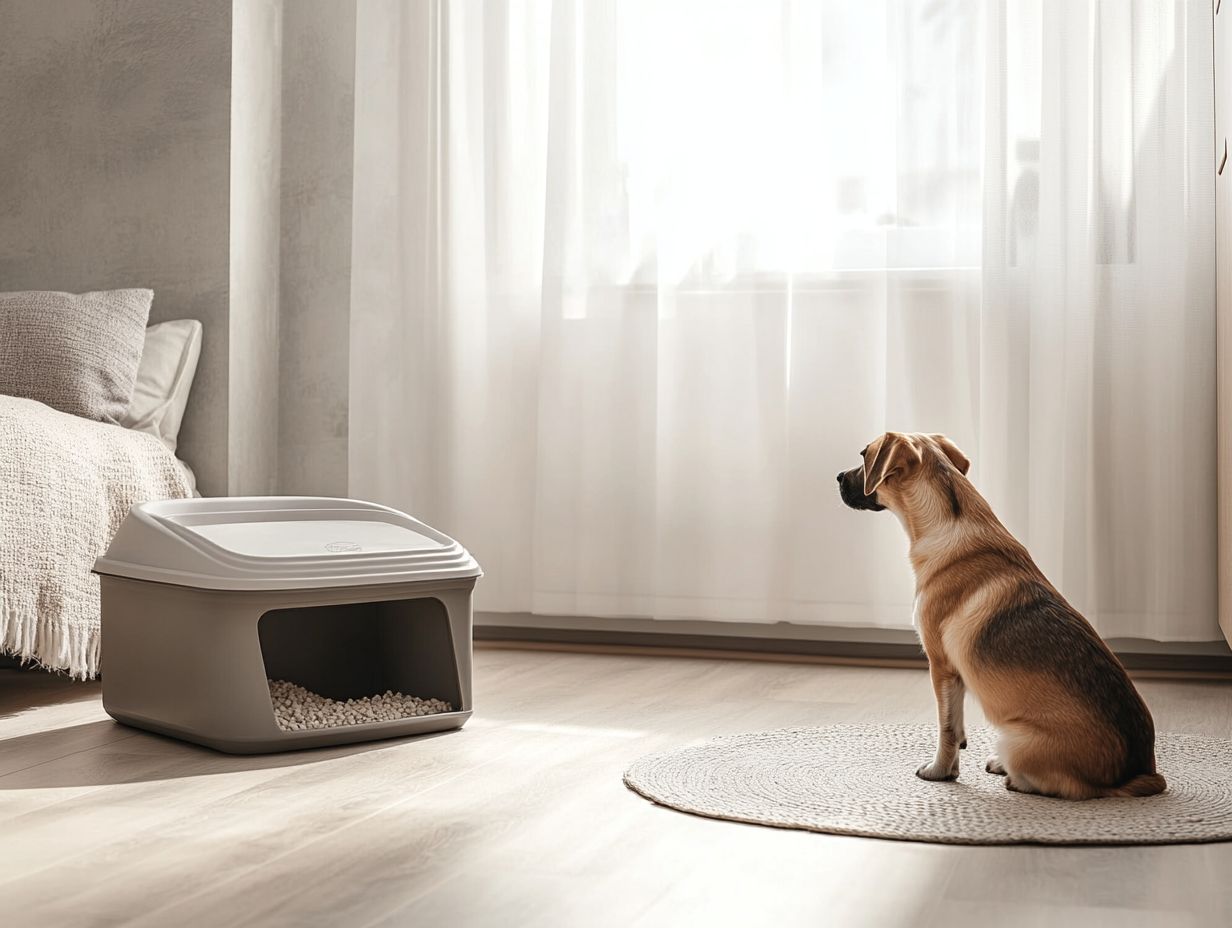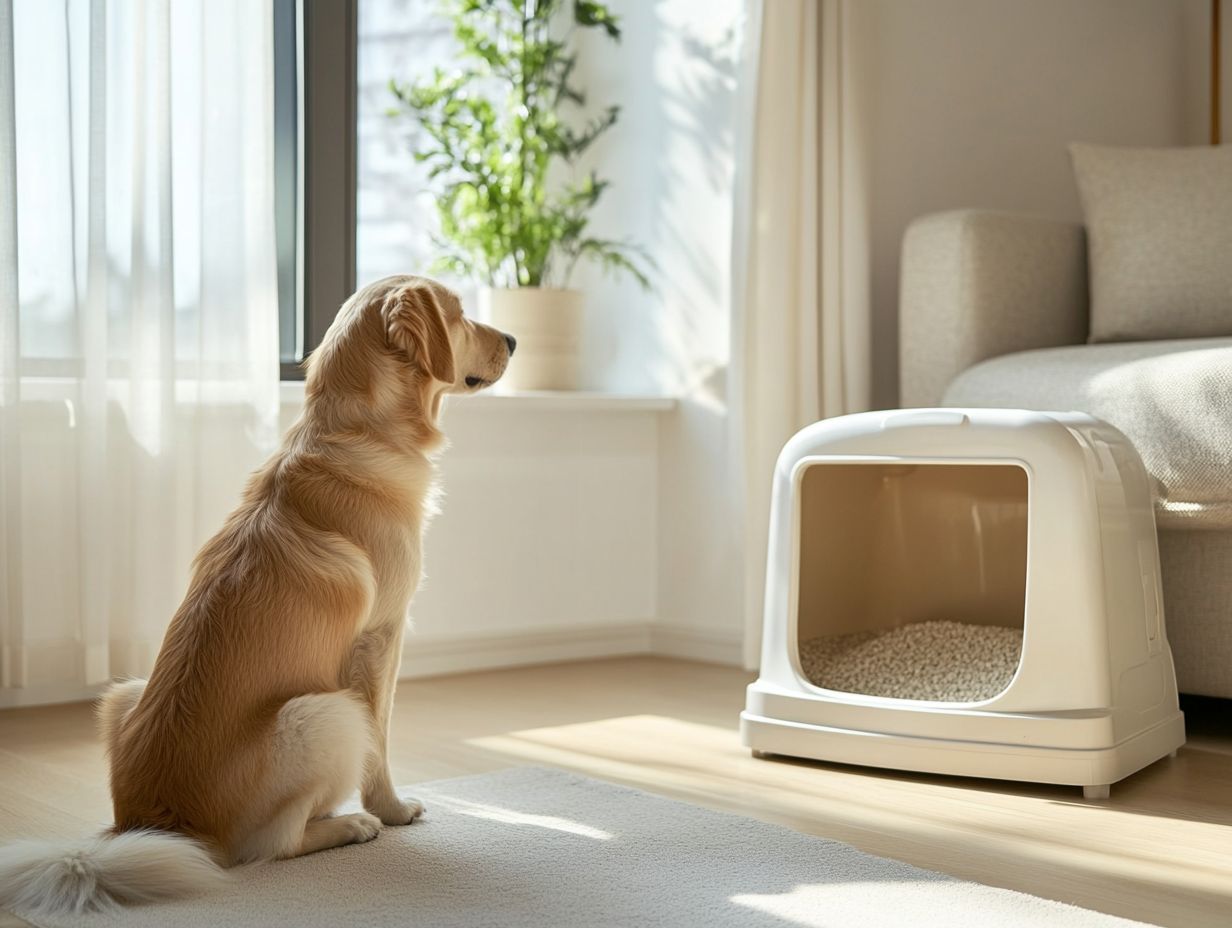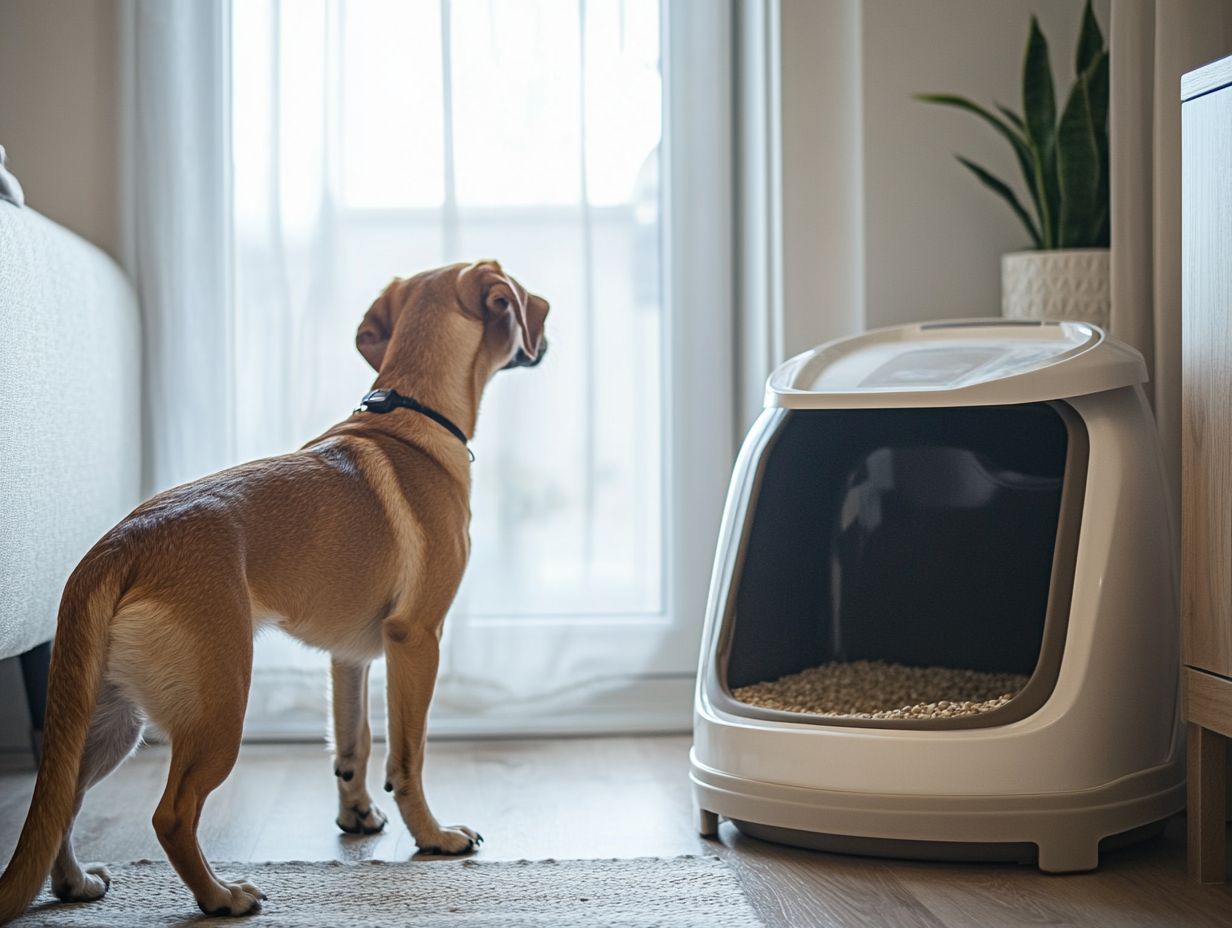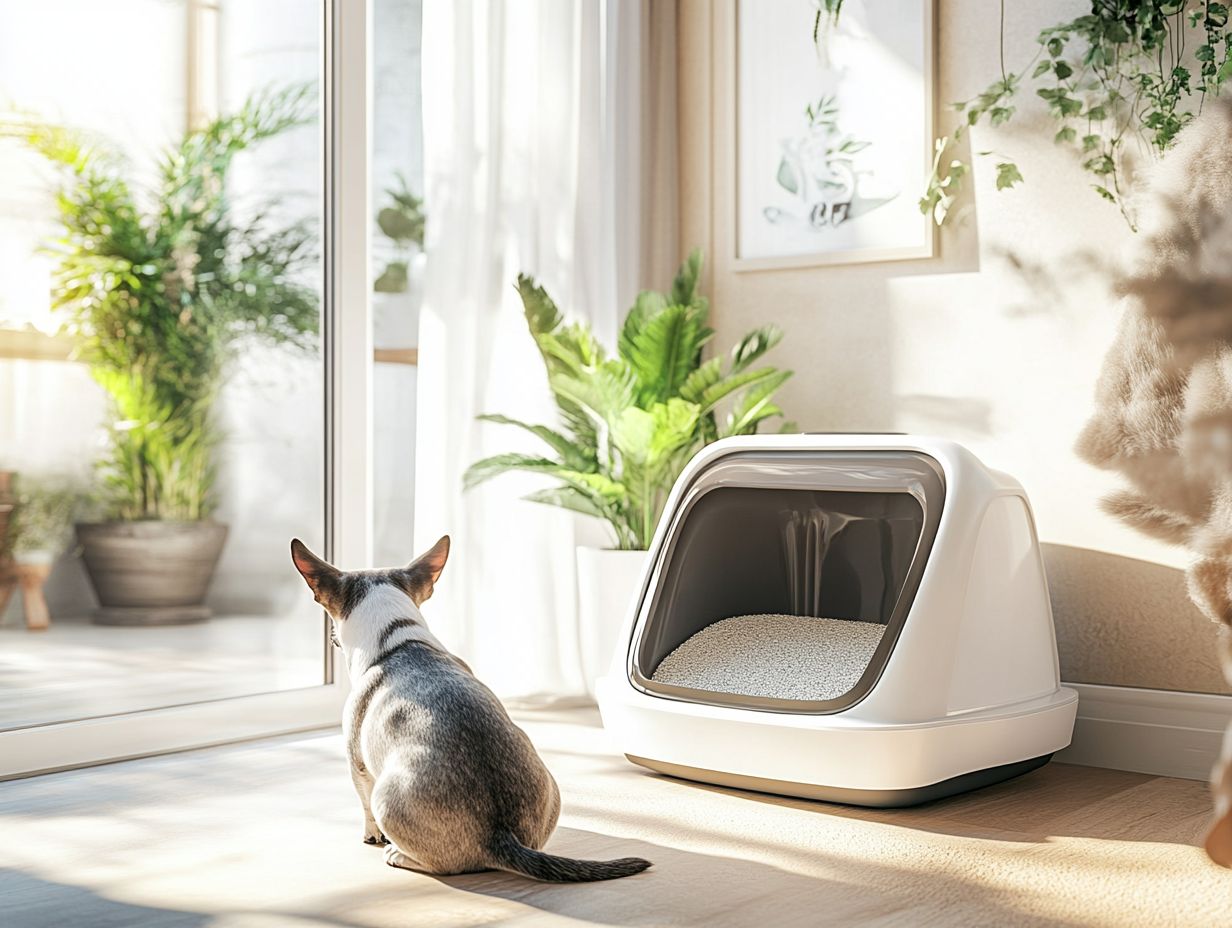If you’ve ever caught your dog sneaking a peek into the cat litter box or even attempting to enter it, you’re not alone! Many pet parents encounter this behavior, which can lead to health risks and messy situations.
This article explores why dogs are drawn to litter boxes, the potential dangers they face, including exposure to cat poop and coprophagia, and effective strategies to keep them away.
Additionally, we share some innovative options for the best dog-proof litter boxes, including top-entry designs and self-cleaning models like the Litter-Robot 3 Connect and 4, to ensure a harmonious home for both your furry friends.
Key Takeaways:

- Avoid health risks for both dogs and cats by preventing dogs from accessing cat litter boxes.
- Elevated and covered litter boxes, such as those from Frisco and Petmate, along with training tips and consulting with a veterinarian, can help keep dogs out of cat litter boxes.
- Keep litter boxes clean, provide dogs with their own space, use barriers like a baby gate or storage crate, and consider dog-resistant furniture for added protection against dog access to cat litter boxes.
Why Do Dogs Try to Get into Cat Litter Boxes?
Dogs are naturally curious creatures and often have a tendency to investigate cat litter boxes, which can lead to problematic behavior. This curiosity may stem from instinct, the appealing smell of cat waste, or a lack of proper training and boundaries set by pet owners.
Understanding why dogs are attracted to cat litter is essential for creating effective dog-proofing strategies that ensure both cats and dogs can coexist happily in the same home while keeping your cat happy and stress-free.
What Are the Risks of Dogs Getting into Cat Litter Boxes?
Dogs can experience health issues and behavioral changes from eating cat litter or feces, making their access to cat litter boxes quite risky. Consuming cat feces can lead to gastrointestinal upset in dogs and expose them to parasites, including Toxoplasmosis, which can pose serious health risks for both the dog and the humans in the household.
Additionally, this behavior may lead to aggressive interactions between cats and dogs, creating a stressful environment for pet owners.
1. Ingesting Cat Litter
The dangers of dogs eating cat litter include the risk of digestive tract obstruction caused by certain types of litter and potential toxicity from specific litter materials. Dogs are naturally inquisitive, and when they gain access to cat litter boxes, they may consume litter out of curiosity or boredom.
Different types of cat litter can pose various dangers. For example, clumping litter, commonly made from sodium bentonite clay, can expand in a dog’s stomach, increasing the likelihood of obstruction. Additionally, litters that contain fragrances or chemicals can be toxic, potentially leading to poisoning, which may result in symptoms such as vomiting or lethargy.
More hazardous materials include clumping litter that expands and those containing potentially toxic fragrances or high sodium content. Pet owners should ensure that cat litter is securely stored out of reach and consider using safer alternative cat litter types. For more information about keeping dogs out of the litter, check out Dog Proof Cat Litter Boxes: Keeping Dogs Out of the Litter.
Providing sufficient mental stimulation for dogs and using dog-challenging toys can also help prevent them from accessing litter boxes in the household.
2. Exposure to Toxoplasmosis
Exposure to toxoplasmosis poses a serious risk to dogs that have access to cat litter boxes, as this parasitic infection can lead to severe health complications. Toxoplasmosis is contracted when dogs ingest oocysts—the cysts produced by the Toxoplasma parasite that can be present in cat feces. While dogs are generally at a lower risk than humans, the dangers still exist, making dog-proof litter essential.
Common symptoms of toxoplasmosis in dogs include lethargy, fever, loss of appetite, and neurological issues. If left untreated, the infection can result in more severe consequences, such as organ damage or chronic infections. Consequently, dog-proofing living spaces is crucial.
To minimize risk, consider the following solutions:
- Use a covered litter box to limit dog access.
- Train dogs with commands to stay away from the litter box area.
- Keep litter boxes in a secure location that dogs cannot reach.
- Consult with a veterinarian for advice on preventing access and health risks.
Conclusion
By employing effective dog-proofing strategies, you can ensure a safe and harmonious environment for both your cats and dogs. Prioritize your pets’ health and well-being by taking the necessary measures to keep them away from each other’s spaces.
- Place litter boxes out of reach
- Use covered litter boxes
- Keep litter boxes clean to reduce exposure
It is crucial to dog-proof litter boxes to protect your pets’ health and maintain harmony in your household. Taking the right precautions can prevent potential health issues and behavioral problems between your pets.
3. Aggressive Behavior Towards Cats
Another risk associated with dogs accessing cat litter boxes is the potential for aggressive behavior towards cats, stemming from competition over resources and territoriality. Dogs may perceive the litter box as a food source or a toy, which can trigger aggressive reactions. For accurate information on this behavior, consider consulting reputable sources such as veterinary behaviorists.
This behavioral dynamic can escalate rapidly, particularly in households with multiple pets vying for the same resources like cat food or attention. Recognizing these factors highlights the importance of proactive management in a multi-pet household.
Effective dog-proofing measures, such as using baby gates and placing litter boxes in hard-to-reach areas, are essential for minimizing the likelihood of conflicts. It is crucial to keep the resources and needs of each pet separate, ensuring that all pets feel safe and respected within their shared environment for a healthy household.
How Can You Prevent Dogs from Getting into Cat Litter Boxes?
Preventing dogs from accessing cat litter boxes can be accomplished through careful placement, the use of dog-proof products (such as covered and elevated boxes), and effective training techniques. Elevated litter boxes, enclosed litter boxes, and dog-proof litter boxes, along with the installation of baby gates, can significantly reduce the likelihood of dogs eating cat litter.
These measures help ensure that both cats and dogs remain happy and healthy.
1. Place Litter Boxes in Elevated Areas

Elevated litter boxes are an effective dog-proofing technique that limits dogs’ access to litter boxes while providing a secure place for cats to relieve themselves. By discouraging dogs’ curiosity and reach, these elevated boxes create a safer environment for cats, which can help minimize contact and reduce the likelihood of aggressive behavior between the two animals.
This setup not only keeps litter boxes cleaner but also decreases the chances of playful paws getting into the box and making a mess, thereby enhancing hygiene for both pets and their owners. Elevating litter boxes encourages pet owners to designate a clean, accessible area exclusively for their feline friends, fostering a more pleasant living environment.
Many elevated designs, such as the PetFusion Ultimate Cat Litter Box and IRIS Top Entry Cat Litter Box, feature cat-friendly elements, such as anti-slip surfaces and easy access, ensuring comfort for the cats. Additionally, placing elevated litter boxes in areas where dogs cannot intrude promotes a peaceful living space that benefits both pets and their owners.
2. Use a Litter Box with a Top Entry
Top-entry litter boxes are a highly recommended method for dog-proofing, as they create an additional barrier that makes it difficult for dogs to access the litter. These boxes also allow cats to comfortably enter and exit without needing to jump up or down from a high position, making them effective for dog-proofing.
Furthermore, top-entry designs significantly reduce litter tracking in the home; the height of the box ensures that litter is primarily contained beneath it. Pet parents will appreciate the reduced mess that a curious dog can create with these models.
Additionally, there are many stylish dog-proof designs available that complement home décor while catering to the needs of both dogs and cats, promoting a healthy and happy living environment for all pets.
3. Install a Litter Box Door
Installing a litter box door is an innovative solution for dog-proofing that allows cats to enter while keeping dogs out of the litter box. These doors can be designed to respond to the weight of cats, ensuring that only your feline friend can use them. This promotes a safe and healthy environment for all pets in the home.
With various styles and sizes available, integrating a litter box door into existing setups is easy. Homeowners can select options that seamlessly blend with their current décor, making the addition less obtrusive.
Key Dog-Proofing Techniques
- Place litter boxes in elevated areas.
- Use covered or top-entry litter boxes.
- Install baby gates to restrict access.
- Train your dog to stay away from litter boxes.
To train dogs to stay away from litter boxes, use simple commands like “leave it” or redirect their attention with toys or treats when they approach the litter box. This reinforces positive behavior and establishes boundaries.
In conclusion, maintaining a harmonious environment between pets requires effort but is essential for their well-being. By implementing these dog-proofing strategies, you can enhance the safety and happiness of both your dogs and cats.
Along with deterring dogs, these doors also help contain odors, helping to maintain a pleasant living space. Many models come equipped with an easy-to-use cleaning feature for easy cleaning and maintenance, ensuring that the litter box area remains hygienic. This functionality highlights a practical approach to pet care that benefits both cats and their human companions. For more tips, read more about dog-proofing cat litter boxes here.
4. Train Dogs to Stay Away from Litter Boxes
Training dogs to avoid litter boxes is essential for creating a pet-friendly home, and this can be achieved through positive reinforcement, such as offering treats or praise when the dog stays away from the litter box, and consistent boundaries. Teaching a dog to steer clear of litter boxes not only fosters a harmonious living environment but also enhances the quality of life for both pets. Consider using the Out of Sight Litter Box, which features a unique design that keeps the litter out of reach, or Litter-Robot models, which are automated and self-cleaning, for additional dog-proofing.
To implement this effectively, it is crucial to establish clear rules from the outset, rewarding the dog for obeying commands and staying away from the litter box area. Distractions, such as toys or engaging play, can be useful for redirecting their attention whenever they show interest in the litter box.
Additionally, physical barriers like fences can reinforce the understanding that certain areas are off-limits. Consistent training and patience are vital to ensuring a successful outcome, allowing both pets to coexist peacefully while enjoying their own spaces.
What Are Some Dog-Proof Cat Litter Box Options?
Here are the top dog-proof cat litter box options. These innovative solutions effectively keep dogs out while providing cats with a comfortable and clean space:
- Covered litter boxes (e.g., PetFusion BetterBox) offer privacy and help contain odors,
- self-cleaning models (e.g., Litter-Robot 3) reduce maintenance efforts,
- enclosed designs (e.g., Catit Jumbo Hooded Cat Litter Pan) prevent dogs from accessing the litter.
1. Covered Litter Boxes with a Small Opening
Covered litter boxes with a small opening are ideal for dog-proofing because they create a space where cats can use the litter box without the fear of being disturbed by dogs. The small opening keeps dogs out while allowing easy access for cats, enhancing both safety and cleanliness. This design can also prevent litter scatter, keeping your home tidier.
Along with safeguarding cats, these litter boxes contribute to a cleaner environment, as the cover helps contain litter spillage and odors, promoting a more sanitary home for both pets and their owners.
In households with multiple pets, these solutions not only protect a cat’s privacy but also prevent dogs from eating cat feces, an unhealthy behavior that can lead to diseases in both animals. Ultimately, covered litter boxes help ensure the well-being of all pets and the comfort of their owners.
2. Litter Boxes with a Hood or Dome
Dog-proof litter boxes featuring a hood or dome design (e.g., IRIS Top Entry Cat Litter Box) are among the safest options for preventing dogs from accessing the litter while also ensuring privacy for cats. This enclosed design aids in odor control and minimizes litter tracking, making it a preferred choice for pet owners seeking the best solutions. However, note that these designs may require more frequent cleaning if heavily used.
The elevated surface prevents dogs from digging in the waste while providing cats with a private space to do their business peacefully. Additionally, the covered design significantly reduces the amount of litter that ends up outside the box, making it easier for pet owners to maintain a clean area.
Many hood and dome litter boxes also include odor-reducing features, such as built-in air filters. Overall, their design keeps the space around the litter box cleaner and more organized, benefiting both pet owners and their pets—especially in households with multiple animals.
3. Self-Cleaning Litter Boxes

Self-cleaning litter boxes (e.g., Litter-Robot 4) provide a relatively dog-proof solution, as they automatically clean themselves and reduce the likelihood of attracting dogs to the litter. These high-tech devices save pet owners time and keep cats cleaner, minimizing the opportunity for dogs to interfere with them.
The automatic scooping and waste disposal features help reduce odors and maintain cleanliness around the litter box. With low maintenance requirements, these products allow pet owners to spend less time worrying about messes and more time enjoying the company of their furry companions.
In conclusion, choosing the right litter box is essential for fostering a healthy environment for both cats and dogs. The best dog-proof cat litter box can significantly improve the quality of life for all pets in your home, ensuring comfort, cleanliness, and peace of mind.
Many models of self-cleaning litter boxes are equipped with sensors that detect when a cat uses the box, keeping it clean and fresh. This not only promotes a cleaner home but also offers convenience for those with multiple pets, providing peace of mind for pet parents. For expert recommendations, visit [reputable source link].
4. Litter Boxes with a Sensor-Activated Door
Litter boxes equipped with sensor-activated doors are some of the most advanced designs for keeping dogs out while allowing only cats to enter. This technology specifically aids in keeping litter boxes private for cats, ensuring they can access their litter without disruption, which provides peace of mind for pet parents.
By utilizing advanced technology, these litter boxes promote better sanitation for both pets and their owners. The sensor detects when a cat approaches and automatically opens the door, closing it again once the cat has entered. This mechanism prevents dogs from entering, allowing cats a private and undisturbed space.
Additionally, these designs are often constructed from easy-to-clean materials, minimizing maintenance efforts. For those who struggle with cleaning or hygiene, these litter boxes are a welcome addition that seamlessly fits into a modern lifestyle.
Other Tips for Keeping Dogs Out of Cat Litter Boxes
Along with using dog-proof litter boxes, pet owners can employ various strategies to keep dogs away from cat litter boxes, focusing on cleanliness and creating separate spaces for each pet. Coprophagia, the behavior where dogs eat feces, can be reduced by implementing these strategies.
Maintaining clean litter boxes and providing dogs with their own toys and designated play areas can further discourage them from being drawn to cat litter, reducing instances of coprophagia.
1. Keep Litter Boxes Clean and Fresh
Regular cleaning of litter boxes is an important aspect of dog-proofing your home, as dogs are less likely to be attracted to areas that are clean and odor-free. Aim to clean the litter box daily and change the litter weekly. Maintaining a clean litter box not only provides a healthy environment for cats but also discourages dogs from sniffing around that area.
A well-maintained litter box can enhance feline health by reducing the risk of urinary tract infections and other ailments associated with unsanitary conditions. Frequent cleaning encourages cats to use the litter box regularly, as the litter is consistently changed and the box is sanitized.
Additionally, a clean litter box area minimizes odors that could attract dogs, further safeguarding the cat’s environment.
2. Provide Dogs with Their Own Space and Toys
Creating a dedicated space for dogs and providing engaging toys are effective dog-proofing strategies that help redirect their curiosity and energy away from cat litter boxes.
By giving dogs their own area filled with engaging toys like a jigsaw puzzle, rubber chew toys, or interactive balls, the likelihood of them wandering into cat territory in search of stimulation is significantly reduced. This dedicated space not only minimizes the chances of conflict between the two pets but also fosters a sense of security and stability for the dog.
When dogs have access to appropriate toys, they can engage in constructive play, which alleviates destructive behavior often associated with boredom or anxiety. A well-planned play area encourages interaction with a dog’s favorite chew toys, balls, or puzzles, leading to healthier outlets for their energy.
Ultimately, a harmonious multi-pet environment becomes more achievable, as both pets will feel more relaxed and valued in their respective spaces.
3. Consult with a Veterinarian for Behavioral Issues
Pet parents can consult veterinarians regarding their pets’ behavioral issues, such as dogs getting into the cat litter box. Common behavioral issues might include curiosity about the litter box, anxiety about sharing space, or improper diet. Veterinarians can provide tailored advice and techniques to curb this behavior, allowing dogs and cats to coexist peacefully.
With their specialized knowledge and experience, veterinarians can identify the underlying motivations for such behaviors, which may include curiosity, anxiety, or dietary needs. They can recommend effective training methods and environmental modifications, such as utilizing training tips and behavioral therapy, to help prevent dogs from accessing litter areas.
Additionally, veterinarians are trained to offer behavioral therapy and may provide nutritional advice and stress-reducing strategies to ensure that both pets not only behave well but also remain healthy and thrive in their environment.
4. Consider Using Baby Gates or Pet Barriers
Using baby gates or pet barriers can create physical separations, ensuring each pet can enjoy their space without interference from the other. This approach is particularly useful in multi-pet households, enhancing overall harmony.
Conclusion
Maintaining separate spaces for dogs and cats, cleaning litter boxes regularly, and providing engaging toys for dogs can significantly improve the living situation for both pets. By implementing these strategies, pet owners can create a peaceful and healthy environment that benefits everyone. For additional resources, consider checking out the best cat litter for litter robot options available.
Using baby gates or pet barriers is an effective and practical method for dog-proofing litter boxes, as these barriers restrict dogs’ access to areas where litter boxes are located. This strategy ensures that cats can safely access their litter boxes while keeping dogs away, promoting a safe space for both cats and dogs. According to Dr. Lisa M. Freeman, a veterinarian and pet behaviorist, using barriers can significantly reduce incidents of dogs accessing litter boxes.
Along with protecting litter boxes, these barriers offer several benefits, including enhanced overall home safety and peace of mind for pet owners, preventing access to cat food and litter. By effectively separating pets, these gates reduce the risk of accidents, such as unintentional snacking on cat food or litter, which can lead to health issues. Specifically, when dogs consume cat litter, it can lead to gastrointestinal problems due to ingredients in the litter and potential clumping in their digestive system.
Their easy installation allows pet owners to set them up in just minutes, making them a convenient solution for households with both cats and dogs. With a variety of styles and sizes available, they can seamlessly blend into existing home decor, providing both functionality and aesthetic appeal.
These strategies not only contribute to a more organized space but also help teach pets boundaries, fostering a more disciplined environment.
Frequently Asked Questions

What is a dog proof cat litter box?
A dog proof cat litter box is a litter box designed to keep dogs out and prevent them from accessing the cat’s litter, such as the Out of Sight Litter Box. It usually has features such as a secure lid, elevated entrance, or specific entrance size to only allow cats to enter. The Out of Sight Litter Box, for example, features a cover that keeps both litter and odors contained, while its specific entry point is too small for most dogs.
Why do I need a dog proof cat litter box?
Dogs are naturally curious animals and may be attracted to the smell and texture of cat litter, particularly if it contains cat poop. This can lead to them digging and potentially consuming the litter, a behavior known as coprophagia, which can be harmful to their health. A dog proof cat litter box helps keep dogs out and ensures the safety of both pets, providing peace of mind for any pet parent.
What types of dog proof cat litter boxes are available at Wal-Mart?
There are various types of dog proof cat litter boxes available, including top-entry litter boxes, litter boxes with secure lids, litter boxes with elevated entrances, and litter boxes with small entrance sizes. Some models, such as the Litter-Robot 3 Connect and Litter-Robot 4, offer automatic cleaning features, while others have electronic or magnetic features that only allow access to the designated cat with a special collar.
How do I train my dog to stay away from the litter box using training tips?
Training your dog to stay away from the litter box can involve using positive reinforcement techniques, such as giving treats like small pieces of chicken or praise when they ignore the litter box. Positive reinforcement means rewarding your dog for good behavior instead of punishing them for bad behavior. You can also try using deterrents, such as placing the litter box in a room with a baby gate that allows the cat to enter but not the dog. Additionally, consider using a storage crate or litter box furniture to make the litter less accessible to dogs.
Can I still use a dog proof cat litter box if I have large cats or multiple cats?
Yes, you can still use a dog proof cat litter box even if you have large cats or multiple cats. It is generally recommended to have one litter box per cat plus one extra to ensure each has access. However, it is important to consider the number of cats and their individual needs when selecting a litter box. Some dog proof litter boxes may be too small for multiple cats, while others, such as those from Frisco or Petmate, may be designed specifically for multiple cats.
Are there any other benefits to using a dog proof cat litter box such as litter tracking reduction?
Aside from keeping dogs out of the litter, there are other benefits to using a dog proof cat litter box. These can include reducing litter tracking, controlling odors, and providing a sense of privacy for your cat. Some boxes, like the Out of Sight Litter Box, offer a top-entry design that minimizes mess and features sealed lids to help with odor control. Additionally, dog proof litter boxes may also be easier to clean and maintain, making both the cat and pet parent happy.
In conclusion, using dog proof cat litter boxes not only protects your pets but also enhances the overall cleanliness and organization of your home. Choosing the right type of litter box for your household’s specific needs is crucial for ensuring a harmonious living environment for all pets involved.